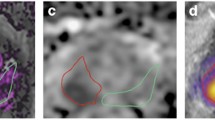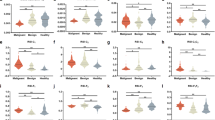Abstract
Purpose
Restriction spectrum imaging (RSI) is a novel diffusion MRI model that separates water diffusion into several microscopic compartments. The restricted compartment correlating to the tumor cellularity is expected to be a potential indicator of rectal cancer aggressiveness. Our aim was to assess the ability of RSI model for rectal tumor grading.
Methods
Fifty-eight patients with different rectal cancer grading confirmed by biopsy were involved in this study. DWI acquisitions were performed using single-shot echo-planar imaging (SS-EPI) with multi-b-values at 3 T. We applied a three-compartment RSI model, along with ADC model and diffusion kurtosis imaging (DKI) model, to DWI images of 58 patients. ROC and AUC were used to compare the performance of the three models in differentiating the low grade (G1 + G2) and high grade (G3). Mean ± standard deviation, ANOVA, ROC analysis, and correlation analysis were used in this study.
Results
The volume fraction of restricted compartment C1 from RSI was significantly correlated with grades (r = 0.403, P = 0.002). It showed significant difference between G1 and G3 (P = 0.008) and between G2 and G3 (P = 0.01). As for the low-grade and high-grade discrimination, significant difference was found in C1 (P < 0.001). The AUC of C1 for differentiation between low-grade and high-grade groups was 0.753 with a sensitivity of 72.0% and a specificity of 70.0%.
Conclusion
The three-compartment RSI model was able to discriminate the rectal cancer of low and high grades. The results outperform the traditional ADC model and DKI model in rectal cancer grading.
Graphical abstract







Similar content being viewed by others
References
Benson AB, Bekaii-Saab T, Chan E, et al. (2012) Rectal cancer. Journal of the National Comprehensive Cancer Network 10: 1528–1564.
Henley SJ, Ward EM, Scott S, et al. (2020) Annual report to the nation on the status of cancer, part I: National cancer statistics. Cancer 126: 2225–2249.
Dworak O, Keilholz L, and Hoffmann A (1997) Pathological features of rectal cancer after preoperative radiochemotherapy. International Journal of Colorectal Disease 12: 19–23.
Kwok H, Bissett I, and Hill G (2000) Preoperative staging of rectal cancer. International Journal of Colorectal Disease 15: 9–20.
Geng Z, Zhang Y, Yin S, et al. (2020) Preoperatively Grading Rectal Cancer with the Combination of Intravoxel Incoherent Motions Imaging and Diffusion Kurtosis Imaging. Contrast Media & Molecular Imaging 2020.
Canda AE, Terzi C, Gorken IB, Oztop I, Sokmen S, and Fuzun M (2010) Effects of preoperative chemoradiotherapy on anal sphincter functions and quality of life in rectal cancer patients. International Journal of Colorectal Disease 25: 197–204.
Chiu Y-W, Kao Y-H, Simoff MJ, et al. (2021) Costs of Biopsy and Complications in Patients with Lung Cancer. ClinicoEconomics and Outcomes Research: CEOR 13: 191.
Bammer R (2003) Basic principles of diffusion-weighted imaging. European Journal of Radiology 45: 169–184.
Birlik B, Obuz F, Elibol FD, et al. (2015) Diffusion-weighted MRI and MR-volumetry-in the evaluation of tumor response after preoperative chemoradiotherapy in patients with locally advanced rectal cancer. Magnetic Resonance Imaging 33: 201–212.
Curvo‐Semedo L, Lambregts DM, Maas M, Beets GL, Caseiro‐Alves F, and Beets‐Tan RG (2012) Diffusion‐weighted MRI in rectal cancer: Apparent diffusion coefficient as a potential noninvasive marker of tumor aggressiveness. Journal of Magnetic Resonance Imaging 35: 1365–1371.
Enkhbaatar N-E, Inoue S, Yamamuro H, et al. (2018) MR imaging with apparent diffusion coefficient histogram analysis: evaluation of locally advanced rectal cancer after chemotherapy and radiation therapy. Radiology 288: 129–137.
Hein PA, Kremser C, Judmaier W, et al. (2003) Diffusion-weighted magnetic resonance imaging for monitoring diffusion changes in rectal carcinoma during combined, preoperative chemoradiation: preliminary results of a prospective study. European Journal of Radiology 45: 214–222.
Mullerad M, Hricak H, Kuroiwa K, et al. (2005) Comparison of endorectal magnetic resonance imaging, guided prostate biopsy and digital rectal examination in the preoperative anatomical localization of prostate cancer. The Journal of Urology 174: 2158–2163.
Barbaro B, Vitale R, Valentini V, et al. (2012) Diffusion-weighted magnetic resonance imaging in monitoring rectal cancer response to neoadjuvant chemoradiotherapy. International Journal of Radiation Oncology* Biology* Physics 83: 594–599.
Peng Y, Tang H, Meng X, et al. (2020) Histological grades of rectal cancer: whole-volume histogram analysis of apparent diffusion coefficient based on reduced field-of-view diffusion-weighted imaging. Quantitative Imaging in Medicine and Surgery 10: 243.
Granata V, Fusco R, Reginelli A, et al. (2019) Diffusion kurtosis imaging in patients with locally advanced rectal cancer: current status and future perspectives. Journal of International Medical Research 47: 2351–2360.
Zhu L, Pan Z, Ma Q, et al. (2017) Diffusion kurtosis imaging study of rectal adenocarcinoma associated with histopathologic prognostic factors: preliminary findings. Radiology 284: 66–76.
Sun H, Xu Y, Song A, Shi K, and Wang W (2018) Intravoxel incoherent motion MRI of rectal cancer: correlation of diffusion and perfusion characteristics with prognostic tumor markers. American Journal of Roentgenology 210: W139–W147.
White NS, Leergaard TB, D'Arceuil H, Bjaalie JG, and Dale AM (2013) Probing tissue microstructure with restriction spectrum imaging: histological and theoretical validation. Human Brain Mapping 34: 327–346.
Brunsing RL, Schenker‐Ahmed NM, White NS, et al. (2017) Restriction spectrum imaging: An evolving imaging biomarker in prostate MRI. Journal of Magnetic Resonance Imaging 45: 323–336.
Humphries PD, Sebire NJ, Siegel MJ, and Olsen ØE (2007) Tumors in pediatric patients at diffusion-weighted MR imaging: apparent diffusion coefficient and tumor cellularity. Radiology 245: 848–854.
Yamin G, Schenker-Ahmed NM, Shabaik A, et al. (2016) Voxel level radiologic–pathologic validation of restriction spectrum imaging cellularity index with Gleason grade in prostate cancer. Clinical Cancer Research 22: 2668–2674.
Bosman FT, Carneiro F, Hruban RH, and Theise ND. (2010). WHO classification of tumours of the digestive system. World Health Organization.
Irfanoglu MO, Nayak A, Jenkins J, and Pierpaoli C. (2017). TORTOISE v3: Improvements and new features of the NIH diffusion MRI processing pipeline. Proceedings of the 25th annual meeting of ISMRM presented at the International Society for Magnetic Resonance in Medicine
Pierpaoli C, Walker L, Irfanoglu M, et al. (2010). TORTOISE: an integrated software package for processing of diffusion MRI data. ISMRM 18th annual meeting
Van RG, and Drake F (2009) Python 3 reference manual. Scotts Valley, CA: CreateSpace.
Stejskal EO, and Tanner JE (1965) Spin diffusion measurements: spin echoes in the presence of a time‐dependent field gradient. The Journal of Chemical Physics 42: 288–292.
DeCarlo LT (1997) On the meaning and use of kurtosis. Psychological Methods 2: 292.
Fieremans E, Jensen JH, and Helpern JA (2011) White matter characterization with diffusional kurtosis imaging. Neuroimage 58: 177-188.
Conlin CC, Feng CH, Rodriguez‐Soto AE, et al. (2021) Improved characterization of diffusion in normal and cancerous prostate tissue through optimization of multicompartmental signal models. Journal of Magnetic Resonance Imaging 53: 628–639.
Morozov S, Sergunova K, Petraikin A, et al. (2020) Diffusion processes modeling in magnetic resonance imaging. Insights into Imaging 11: 1–9.
Hanley JA, and McNeil BJ (1982) The meaning and use of the area under a receiver operating characteristic (ROC) curve. Radiology 143: 29–36.
Andreassen MMS, Rodríguez-Soto AE, Conlin CC, et al. (2021) Discrimination of breast cancer from healthy breast tissue using a three-component diffusion-weighted MRI model. Clinical Cancer Research 27: 1094–1104.
Le Bihan D, Breton E, Lallemand D, Grenier P, Cabanis E, and Laval-Jeantet M (1986) MR imaging of intravoxel incoherent motions: application to diffusion and perfusion in neurologic disorders. Radiology 161: 401–407.
He B, Ji T, Zhang H, et al. (2019) MRI‐based radiomics signature for tumor grading of rectal carcinoma using random forest model. Journal of Cellular Physiology 234: 20501–20509.
Funding
This research was supported by the National natural Science Foundation of China (Grant Numbers 61901462 and 81801724), the Guangdong Grant Key Technologies for Treatment of Brain Disorders’ (Grant Number 2018B030332001), the Scientific Instrument Innovation Team of the Chinese Academy of Sciences (Grant Number GJJSTD20180002), The International Partnership Program of Chinese Academy of Sciences Grant (Grant Number 154144KYSB20180063), and the Strategic Priority Research Program of Chinese Academy of Sciences (Grant Number XDB25000000).
Author information
Authors and Affiliations
Corresponding authors
Ethics declarations
Conflict of interest
All the authors declare that they have no conflict of interest.
Ethical approval
This retrospective study involving human participants were in accordance with the ethical standards of the Institutional Research Committee and with the 1964 Helsinki Declaration and its later amendments. The Human Investigation Committee (IRB) of Sun Yat-sen University Cancer Center approved this study.
Informed consent
Informed consent was obtained from all individual participants included in the study.
Additional information
Publisher's Note
Springer Nature remains neutral with regard to jurisdictional claims in published maps and institutional affiliations.
Zhongyan Xiong, Zhijun Geng, and Shanshan Lian have contributed equally to this work.
Rights and permissions
About this article
Cite this article
Xiong, Z., Geng, Z., Lian, S. et al. Discriminating rectal cancer grades using restriction spectrum imaging. Abdom Radiol 47, 2014–2022 (2022). https://doi.org/10.1007/s00261-022-03500-w
Received:
Revised:
Accepted:
Published:
Issue Date:
DOI: https://doi.org/10.1007/s00261-022-03500-w




